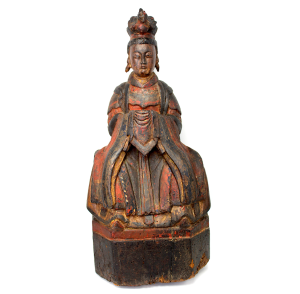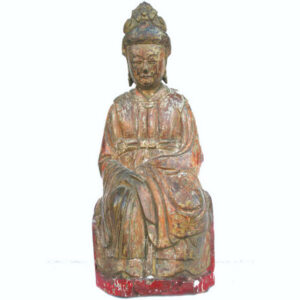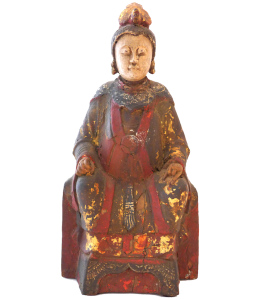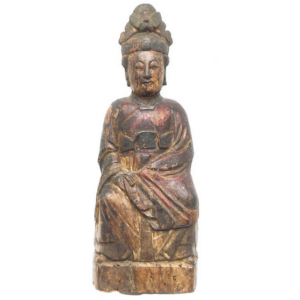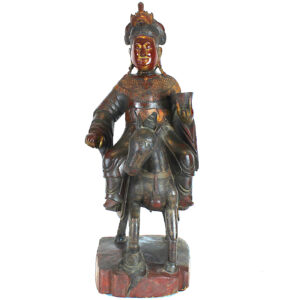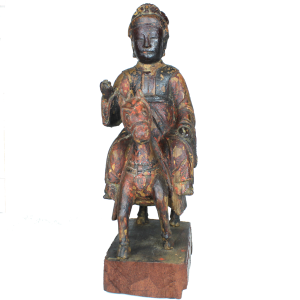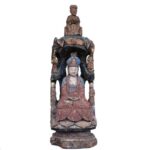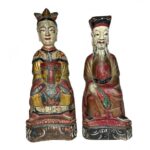Queen Mother of the West Xiwangmu : Taoism’s Iconic Female Sovereign of Immortals
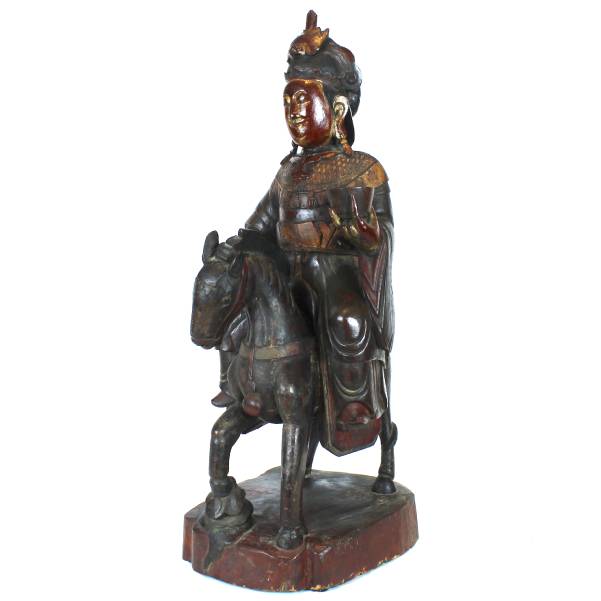
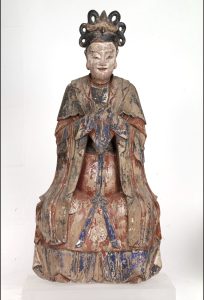
The Taoist deity Queen Mother of the West Hsi Wang Mu or Xiwangmu is revered as the most significant female deity in the Taoist pantheon and is also highly regarded in Chinese Popular Folk Religion where she is seen as a major magical deity with a huge cult following. Her immeasurable powers include her complete control over life and creation as well as death and destruction. On a individual level, she determines the lifespan of every living being, and on a broader scale she initiates the onset of major disasters. She has experienced many historical transformations and is known by many names by her devotees: the Royal Lady of the West, the Ruler of the Western Heavens, the Controller of Time and Space and Death, Golden Mother, and Golden Mother Primordial Sovereign, as well as the affectionate names Auntie Queen Mother and Granny of the West. A beloved deity, she is regarded as the keeper of the Tao, the grantor of prosperity, and the goddess of righteousness. She lives in the mythical Western Paradise in the Kunlun Mountains in a golden palace with jasper and marble buildings, a tower by a lake named Yaochi (meaning jasper), and on luxuriant grounds filled with sparkling brooks, white cranes, red phoenixes, and peach trees so rich in fragrance they can be detected from miles away. Her palace is the dwelling of the Immortals, a paradise faithful practitioners of the spiritual way may reach.
Her famed peach tree (p’an-t’ao) orchard is located on sumptuous encircling the palatial estate and bears the fruit known as the Chinese “flat peach,” once every 3000 years and offers immortality to whoever eats it. Legend has it that important mortals, Taoist masters, and emperors visited her at Mount Kunlun for centuries to learn the esoteric doctrines she taught, be entertained at her banquets, and eat her magic peaches. It was believed that when the peach trees bloom, all immortals are invited to renew their immortality at a sacred feast with peaches as dessert and that takes place on the Queen Mother’s birthday.
The Jade Emperor, the Primordial Lord of Heaven, granted Xiwangmu control over the peach tree orchard, and, as their guardian and the major divinity who oversees the Golden Register Ritual for Prolonging Life, she was a powerful yin (female) symbol of longevity controlling both immortality and the afterlife. He also made her the supreme matriarch who rules all spirits and perfected saints of all heavens and their attendants and also ruler of all women attaining immortality in both the heavenly and the human realm. She is associated with metal (one of the Five Elements), autumn, and the West, all aspects of the yin female force, and, as the oldest female deity of China, she is regarded as a powerful and independent deity and the eternal goddess who first “obtained the Tao.”
Xiwangmu was the first Chinese deity to be represented in Chinese art, and as early as the first century B.C.E., her image graced burials for the wealthy by being placed in the upper part of tombs to symbolize a heavenly space. Later, when the Chinese made images of the Buddha, they partially based them on her using similar physical features, iconography, and tomb placement. She is recognized by a single phoenix in her headdress, a key iconographic feature since the Yuan dynasty (1260-1368) and an emblem of beauty symbolizing the sun and eternal life. In early paintings and sculpture, she was depicted as a beautiful female wearing the flowing robes of a Chinese princess with an elaborate crown topped with an outstretched phoenix. She was often depicted holding the peach of immortality growing in her heavenly orchard.
During the Ming and Qing dynasties, she attracted a very strong following, as she, like Guanyin, became popular among the common people as a source of inspiration and power to help their lives. As a cult figure, images of her were often carved by local artisans who took liberties with her features, iconography, and the unique ways they depicted her which departed from and made them different from sanctioned and imperial statues. She was transformed into a mature ruler, sometimes imperial and sometimes more humble with modest robes and crown, sometimes grasping a cup with the elixir of longevity that only she knows how to make and uses to confer immortality on the worthy. Her images appeared in large Taoist temples dedicated to her and well as in small Popular Folk Religion temples and community and home shrines.
These smaller shrine and altar figures displayed in homes and family shrines in rural areas were never sanctioned by religious, imperial, or government cultural orthodox entities. As a result, many provincial carvings appear more like folk deities making them more accessible, modest and charming rather than ornate, refined, and strictly formulaic.
Larger carvings appeared in community and cult Temples dedicated to her while small figurines often appear along with Buddhist and Taoist images. Local adaptations sometimes included her astride a horse, similar to other Taoist guardian figures, as a seated Taoist official with hands hidden under a ritual cloth, or with her right hand clasping the left sleeve.
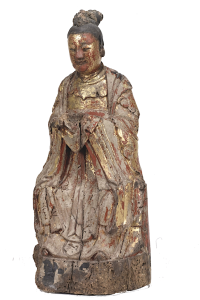
Today, Xiwangmu is still revered as a patron deity of women, a divine teacher who controls the length of people’s lives, and is closely associated with cultivating virtue and immortality. According to Taoist traditions, she like other Taoist deities can only be fully perceived through love and meditation and be experienced through faith, and she has no power over those not initiated into Taoism. She was originally viewed as the special patron deity of royalty, and countless pilgrims frequented her temples and shrines. In recent centuries Taoism has expanded its following, and today her followers reflect a diverse and broader range of devotees in China, Taiwan, Hong Kong, and overseas Chinese communities who are attracted to her close association with virtue and immortality. She is the patron saint of women, especially brides and is always worshiped at the birth of a daughter. On her birthday Taoists, especially women, gather in temples to hold celebratory birthday rituals for her and to pray for their own health and longevity. Authentic antique images of Xiwangmu are extremely rare and highly collectible.
Published Sources
Suzanne Cahill, Transcendence and Divine Passion: The Queen Mother of the West in Medieval China, Palo Alto, Stanford University Press, 1993.
Wolfgram Eberhard, A Dictionary of Chinese Symbols: Hidden Symbols in Chinese Life and Thought, New York, Rutledge, 1998.
Lee Irwin, “Divinity and Salvation: The Great Goddesses of China” in Asian Folklore Studies, Bloomington, Indiana University, Vol. 49, 1990.
Stephen Little, Taoism and the Arts of China, Berkeley, University of California Press, 2000.
Jeremy Roberts, Chinese Mythology A to Z, New York, Facts on File, 2004.
Keith Stevens, Chinese Gods: the Unseen World of Spirits and Demons, London, Collins and Brown, 1997.
Po Sung-Nien and David Johnson, “Domesticated Deities and Auspicious Emblems: The Iconography of Everyday Life in Village China,” Nanzan University Asian Folklore Studies, Vol. 53, No.1, 1994.
Patricia Bjaaland Welch, Chinese Art: A Guide to Motifs and Visual Iconography, North Clarendon, Tuttle Publishing, 2008.
E.T.C. Werner, Myths and Legends of China, Mineola, Dover Publications,1994.
C.A.S. Williams, Chinese Symbolism and Art Motifs, Edison, Castle Books, n.d.
Chung-fang Yu, Guanyin: The Chinese Transformation of Avalokitesvara, New York, Columbia University Press, 2001.
Online Sources
Lisa Parresol, “Transformation of the Chinese Daoist Goddess of Immortality: the Queen Mother of the West (Xiwangmu) and of the Chinese Buddhist Goddess of Mercy: the Bodhisattva Guanyin (Avalokitesvara)”, www.visonaryimage.com mythopedia.
Mythopedia, “Chinese gods: Xiwangmu”
Po Sung-Nien and David Johnson, “Domesticated Deities and Auspicious Emblems: The Iconography of Everyday Life in Village China,” Asian Folklore Studies, Vol. 53, No. I, 1994.
Dr. Thomas Ritter, “The Tao of Horsemanship” – Chapter One, 2005. artistic dressage
The Art Institute of Chicago, “Taoism and the Arts of China,” 2000.
Laura Zinct, “Inquiry Report on the Chinese Goddesses Hsi Wang Mu and Ma-tsu,” St. Thomas University, Archived from the Original on August, 23, 2008.

